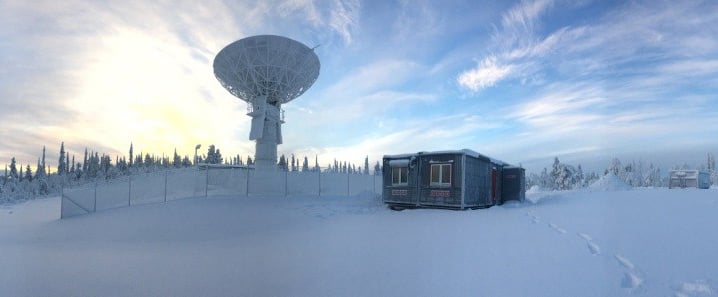How Orbital’s new wideband Ka-band LNA keeps you in the fast lane wherever you are
As the Earth’s orbit traffic problem intensifies, satellite operators are moving quickly to find some elbow room in orbits other than GEO. Many have moved to Low Earth Orbit, or LEO, in hopes of avoiding congestion and transmitting lower-latency, higher-performance broadband signals.
With roughly 20,000 human-made objects in orbit, mostly in the GEO and MEO constellations, it’s no wonder LEO is attracting attention. In addition to less traffic, LEO’s close proximity to our planet makes it easier – and more economical – to transmit high quality, high volume and low latency signals to teleports or gateways on Earth.
To take full advantage of LEO satellites, however, these internet access points need wideband Ka low noise amplifiers (LNAs) that can handle the signal effectively and deliver broadband to consumers wherever they are – even in remote research stations or far-flung communities throughout the Canadian North or rural Africa.
Why LEO?
LEO constellations are poised to become the preferred satellite networks of the future for 4 primary reasons:
- Latency – Because LEO constellations are closer to Earth, latency is significantly reduced. In real terms, it means a broadband satellite signal can deliver the same speed as fibre optic technology. Among other benefits, this has the potential to empower remote communities with reliable, fibre-quality broadband.
- Broadband – Again, because of the closer proximity, LEO satellites can transmit much broader bandwidth to Earth. This is ideal for mobile and SATCOM-on-the-Move (SOTM) applications. Drone video footage, for example, could be streamed via satellite in real time, anywhere on the planet.
- Resiliency – Because LEO satellites are constantly on the move, the constellation is less prone to satellite jamming. This is an important feature for many industries, especially the ones that depend on the reliable, free flow of information.
- Cost – LEO satellites are far more economical than GEOs. They are cheaper to manufacture and to place in orbit, making it economically viable to place spares in the constellation as back-up should the primary satellite fail. In addition, the closer proximity to earth reduces the cost of emitting a reliable broadband signal to earth’s receivers.
Why LEO + wideband Ka-band LNAs = universal broadband
The Ka-band spectrum is ideal for high-performance broadband networks. To capture more of this spectrum from LEO satellites, many companies are turning to wideband Ka-band LNAs for their gateways, teleports, and tracking, telemetry and control (TT&C) stations. This type of RF amplifier can receive the powerful LEO transmissions effectively and, in turn, deliver high data throughput to end users – economically.
Delivering internet to the furthest reaches of the globe hasn’t always been a priority (nor viable), but now, with LEO satellite broadband capabilities, universal broadband is within reach. And the advantages of satellite broadband are many:
- No reliance on fixed connections
- A gateway terminal (dish) equipped with a wideband Ka-band LNA can aggregate significant amounts of user terminal traffic to deliver secure, reliable internet service globally
- End user speeds are comparable to terrestrial services and are continuously improving
Delivering socio-economic benefits
The innovation delivered by the latest LEO satellite technology extends broadband services to underserved regions of the world – minus the latency previously associated with more distant satellite (GEO) technology. This, in turn, will drive some key socio-economic benefits:
Productivity – The online digitization of tasks will enhance labour and capital productivity. With consistent access to email, for example, workers and businesses can communicate and do business more efficiently from remote locations. Not to mention, reliable access to mobile banking will facilitate easier transactions and financing.
Access to information – Reliable access to dynamic information on matters like weather conditions, for example, helps farmers optimize their operations and produce better crops and outputs. In addition, government and public service notifications for things like hurricanes, earthquakes, flooding, and even epidemics, can be disseminated in a timely manner – potentially saving lives and minimizing destruction.
Market access – For those living remotely, reliable internet reduces the effect of geographical isolation, providing inhabitants with access to products and information previously unavailable to them. For both business and retailers, reaching remote customer markets will help boost trade and revenues.
Moreover, investment in remote communities is more attractive knowing the infrastructure that delivers broadband internet is secure and reliable.
Education and skills – Higher education can be accessed by a broader cross-section of humanity. Reliable connectivity will allow people to learn and develop new skills that can serve to improve their communities and enhance their economies.
Whether stimulating economic development in areas previously hampered by poor internet access, or downloading a movie to your mobile device on a cruise ship in the middle of the Pacific, the impact of LEO satellite broadband will be as profound as that of 5G fibre optic networks. Wideband Ka LNAs will enable the delivery of next-generation LEO satellite broadband transmission to the most remote corners of the world, developing countries, navy and cruise ships, and other hard-to-reach places. The lower latency, higher data throughput and better performance delivered by this innovative technology goes a long way toward further democratizing the internet and quenching the insatiable, global thirst for reliable bandwidth.
Do you need a wideband Ka-band LNA for your LEO satellite sooner rather than later? Orbital’s high-performance units provide 2.5 GHz of bandwidth, from 17.7 to 20.2 GHz, and can be delivered in weeks, not months.
